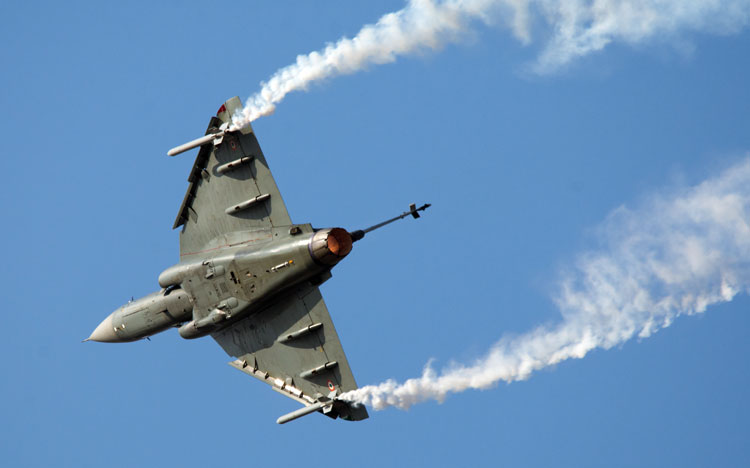INDIAN ARMED FORCES CHIEFS ON OUR RELENTLESS AND FOCUSED PUBLISHING EFFORTS

The insightful articles, inspiring narrations and analytical perspectives presented by the Editorial Team, establish an alluring connect with the reader. My compliments and best wishes to SP Guide Publications.

"Over the past 60 years, the growth of SP Guide Publications has mirrored the rising stature of Indian Navy. Its well-researched and informative magazines on Defence and Aerospace sector have served to shape an educated opinion of our military personnel, policy makers and the public alike. I wish SP's Publication team continued success, fair winds and following seas in all future endeavour!"

Since, its inception in 1964, SP Guide Publications has consistently demonstrated commitment to high-quality journalism in the aerospace and defence sectors, earning a well-deserved reputation as Asia's largest media house in this domain. I wish SP Guide Publications continued success in its pursuit of excellence.
Sukhoi, LCA and More
Charting a course for self-sufficiency and strengthening India's defence arsenal
 |
The Author is Former Director General of Information Systems and A Special Forces Veteran, Indian Army |

On September 15, 2023 the Defence Acquisition Council (DAC), chaired by Defence Minister Rajnath Singh, approved a number of proposals totaling 45,000 crore to bolster the combat capabilities of the Armed Forces. A statement released by the ministry of Defence (MoD) said that among them, the DAC has granted Acceptance of Necessity (AoN) to procure 12 Su-30 MKI fighter aircraft with associated equipment for the Indian Air Force (IAF), from the state-owned Hindustan Aeronautics Limited (HAL).
The Russian-origin Su-30 MKI fighter jets have had a good flight safety record. The IAF had inducted 272 of these jets commencing 2000. As of April 2023, 12 Su-30 MKIs had been lost to crashes. Media has quoted unnamed officials to say that once these 12 Su-30 MKI fighter jets are procured and inducted, the IAF's Su-30 fleet will be back to the planned levels by replacing the aircraft lost over the years.
Defence Minister Rajnath Singh's call for a minimum of 60-65 per cent indigenous content, sets a new milestone for India's defence industry, bolstering the vision of 'Atmanirbhar Bharat'
One media report has cited government officials to say that these Su-30 MKIs will have to be equipped with more than 60 per cent indigenous content; these would be the most modern Su-30 MKI aircraft of the IAF mounted with multiple Indian weapons and sensors. Hence, the time schedule of procuring and inducting these 12 Sukhoi into the IAF remains a question mark, given that these fighter jets are to be 'manufactured' by the HAL whose record of meeting time-schedules has been extremely poor to say the least. As brought out by one paper, the "manufacture" part is to impress the voters but actually these Su-30 MKI fighter aircraft will be flown in from Russia and fitted with indigenous sensors and weapons at the HAL. Otherwise, the HAL would likely take a decade or two to 'manufacture' these Russian-origin fighter jets.

The DAC also accorded AoNs for the procurement of Dhruvastra short range air-to-surface missile (ASM), which is to be fired from the HAL-made Advanced Light Helicopters (ALH) Mk-IV. This precision guided missile (PGM) has been designed by the Defence Research Development Organisation (DRDO). The IAF will also be getting avionic upgrades of Dornier aircraft to improve the accuracy and reliability for operations and the Dhruvastra short range ASM.
DAC's approval of 12 Su-30 MKI fighter aircraft with advanced indigenous weaponry marks a pivotal moment in reinforcing the Indian Air Force's combat capabilities
In addition to the above, for enhancing protection, mobility, attack capability and increased survivability of mechanised forces, the DAC also issued AoNs to procure Light Armoured Multipurpose Vehicles (LAMV), Integrated Surveillance and Targeting System (ISAT-S), and High Mobility Vehicle (HMV) Gun Towing Vehicles for swift mobilisation and deployment of Artillery Guns and Radars. For the Indian Navy, the DAC approved the procurement of Next Generation Survey Vessels that will greatly enhance its capabilities in performing Hydrographic Operations.
Defence Minister Rajnath Singh said that it is time to upgrade the ambitions towards indigenisation, "Rather than a threshold of 50 per cent indigenous content for IDDM projects, we should aim for a minimum 60-65 per cent indigenous content." He also directed the Chief of Defence Staff (CDS), Service Chiefs, Defence Secretary and DG (Acquisition) to work towards increasing the minimum indigenous content threshold in consultation with the Indian Industry. The MoD issued a statement that read, "All these procurements will be made from Indian vendors under the Buy (Indian-Indigenously Designed Developed and Manufactured (IDMM)/Buy (Indian) category which will give a substantial boost to the Indian defence Industry towards achieving the goal of 'Atmanirbhar Bharat."

The above looks good in terms of improving the combat capabilities of the Armed Forces. At the same time, we must acknowledge that an AoN is only the first step in the long defence procurement process, and more importantly, it does not necessarily lead to a final order as has happened in scores of cases in the past, which continue to drag or are lost altogether for multiple reasons. Moreover, the lengthy defence procurement procedure and extraordinary prolonged development time are on record – take just two examples of the development time taken for the Kaveri engine and the LCA Tejas. Taking a cue from the development of the LCA Tejas, in what timeframe would HAL "manufacture" the 12 Su-30 MKI fighter jets?
Precision meets Power! Dhruvastra short-range air-to-surface missile to elevate the accuracy and reliability of HAL's Advanced Light Helicopters.
It is also time to start taking holistic views of defence requirements. For example, the IAF had already lost 12 Su-30 MKIs fighter jets in crashes by April 2023. Shouldn't we have started looking for replacements when say 7-8-9 of these had crashed? The approval of "additional" 100 Tejas fighter aircraft for the IAF, as reported in these columns earlier, by 2028-2029 remains a question mark, looking at HAL's past record.Moreover, India has been showcasing the LCA Tejas abroad at air shows and even bidding for some contracts to gain experience in competing against other foreign aircraft in tenders on foreign shores – like in Malaysia which did not materialise. Already, several nations have begun showing interest in the Tejas. Nigeria is the latest to have expressed its interest in the LCA as part of a $1-billion deal it seeks with India to enable the development of the former's military-industrial complex. In July 2023, when Argentinean Defence Minister Jorge Taiana was on an official visit to India, media speculated Argentina wanted to clinch a deal with India for buying the Tejas aircraft for its air force.
HAL has just begun production of the 83 Tejas Mk1A variants to meet the 48,000-crore order from IAF, with deliveries of the first aircraft scheduled in February 2024. From the existing capability to produce eight Tejas aircraft a year till recently, HAL has ramped up its production of the jets with an additional assembly line at the LCA Complex in Bengaluru. This gives HAL the leverage to build 16 aircraft a year at present. This means HAL would take about five years to supply the entire order for 83 jets to the IAF. Additional 100 Tejas Mk1A jets approved for the IAF implies a minimum of another five years of production of Tejas for IAF; indicating a timeline of 2033-34 till when HAL would be busy meeting the IAF orders for Tejas. Isn't it therefore naïve to export the Tejas fighters when the combat squadrons of the IAF are far below the required 42?





